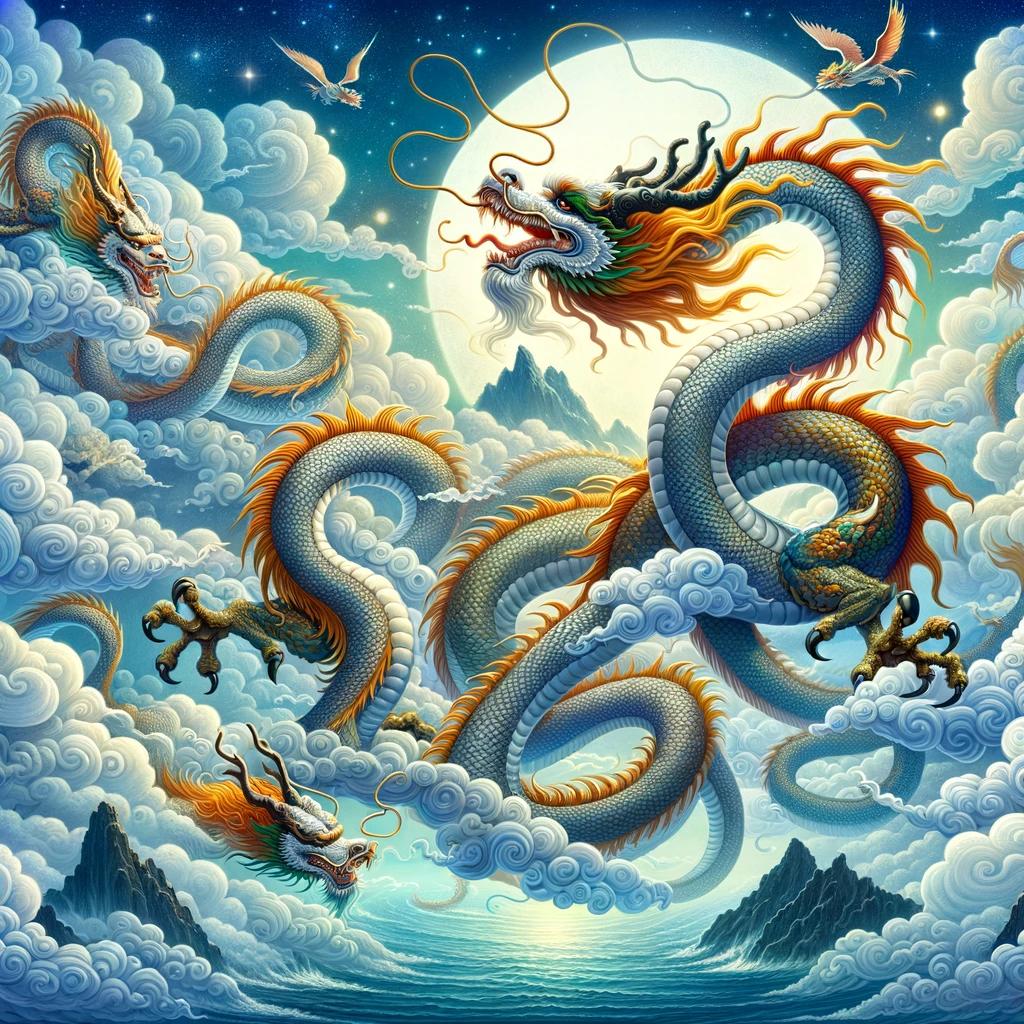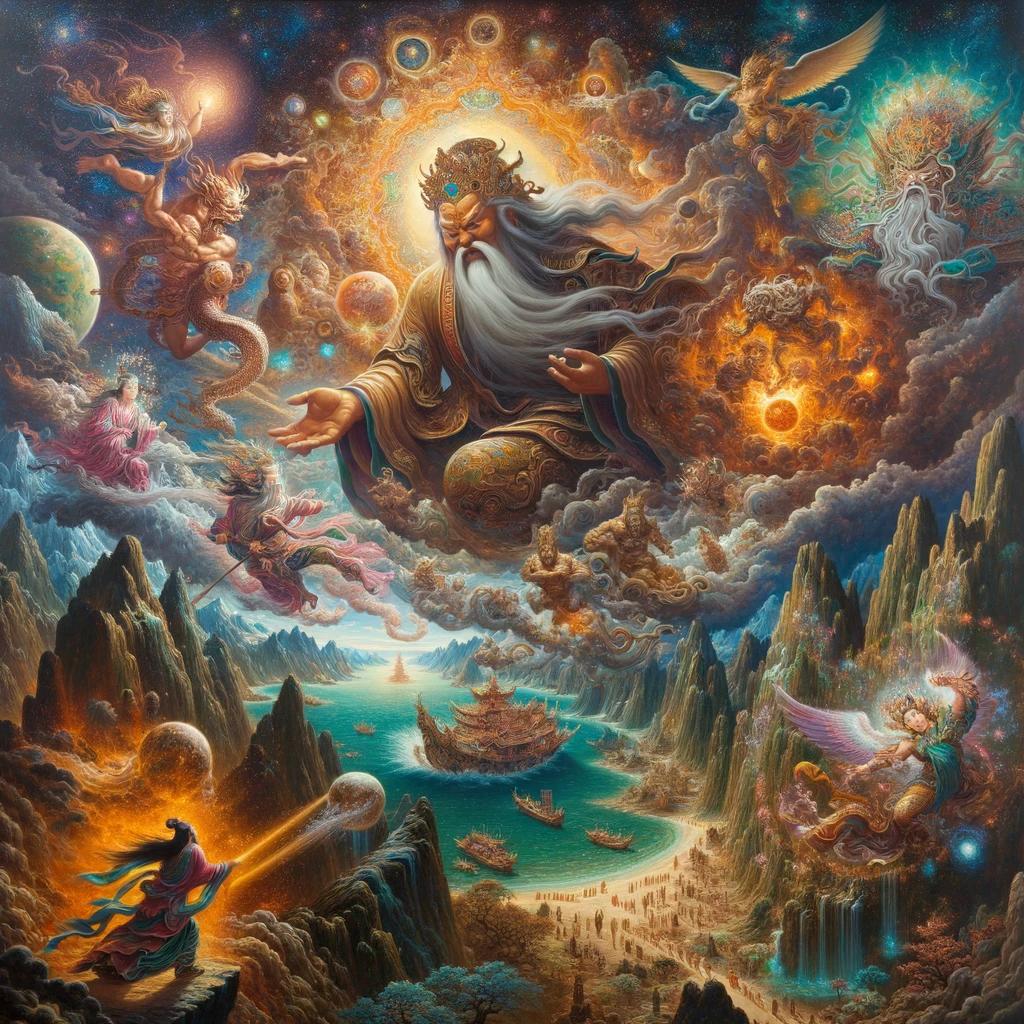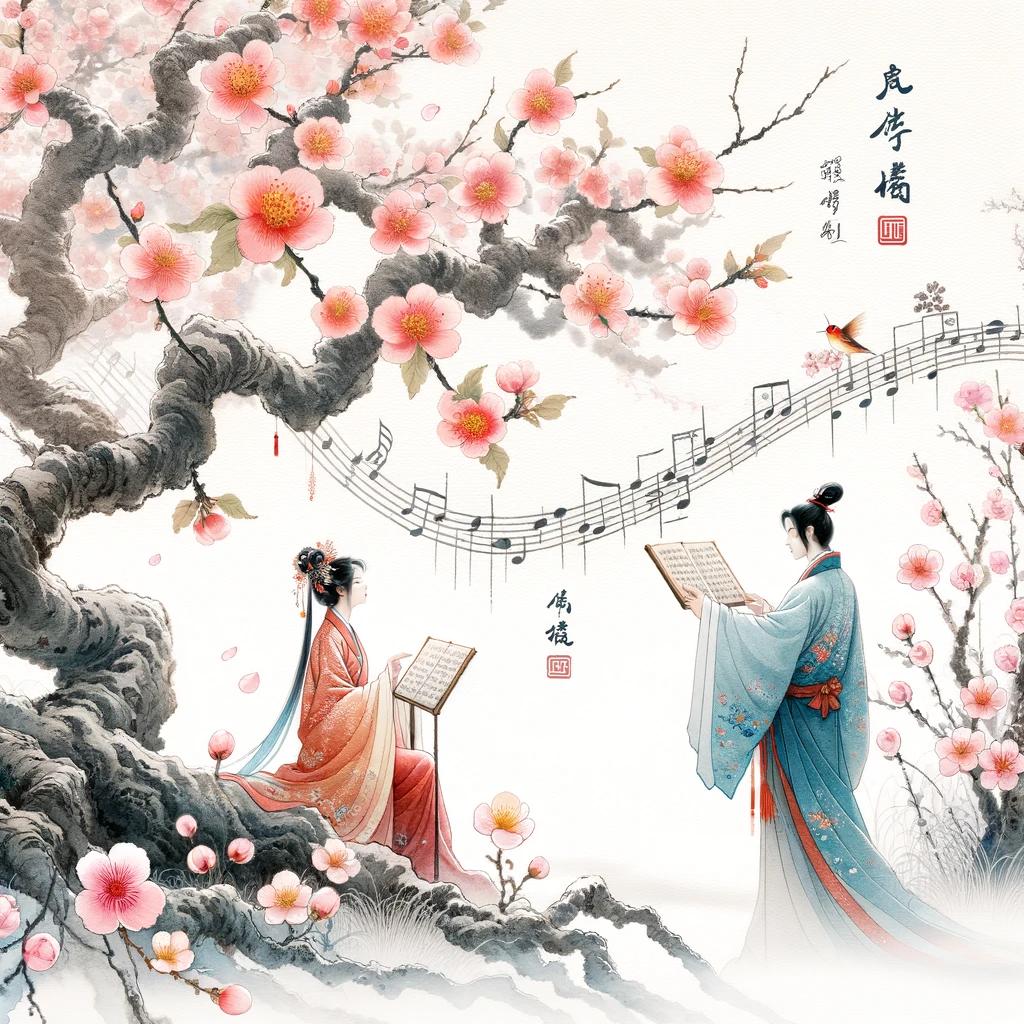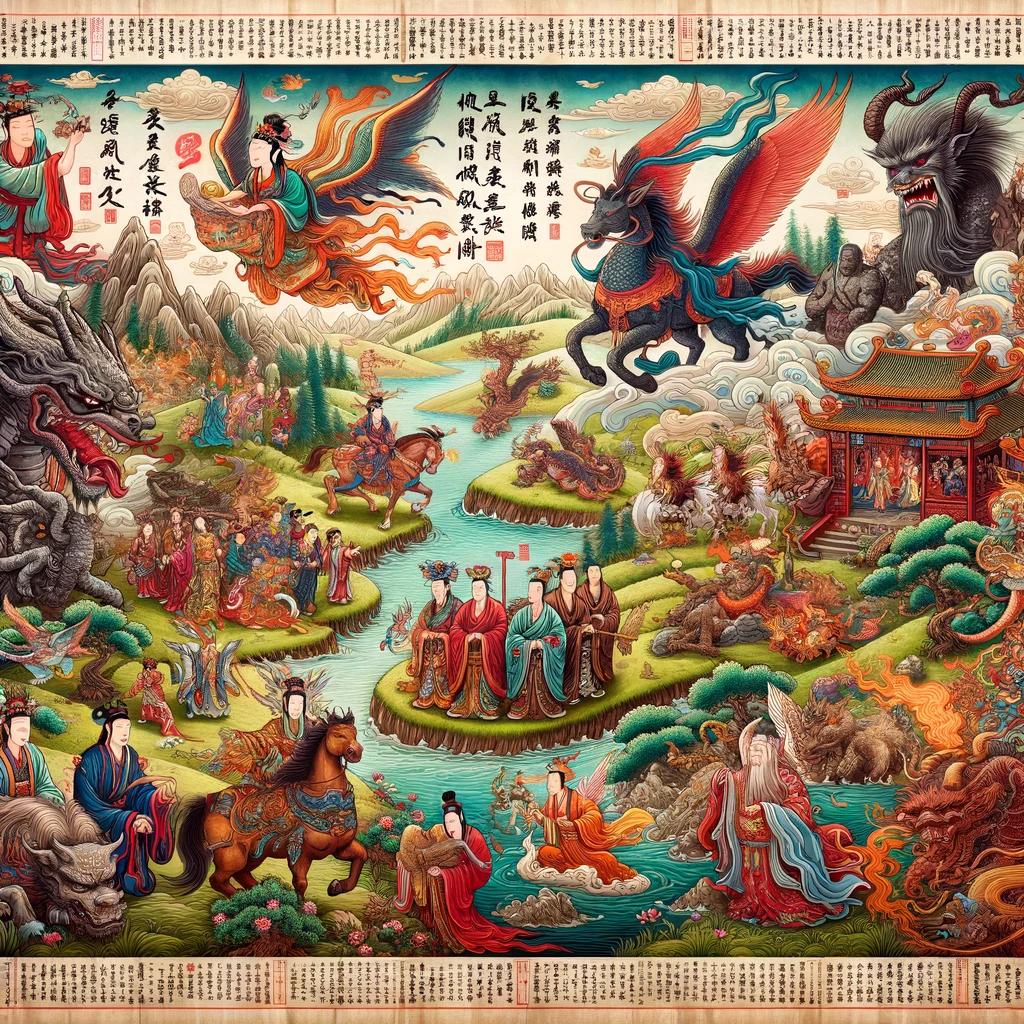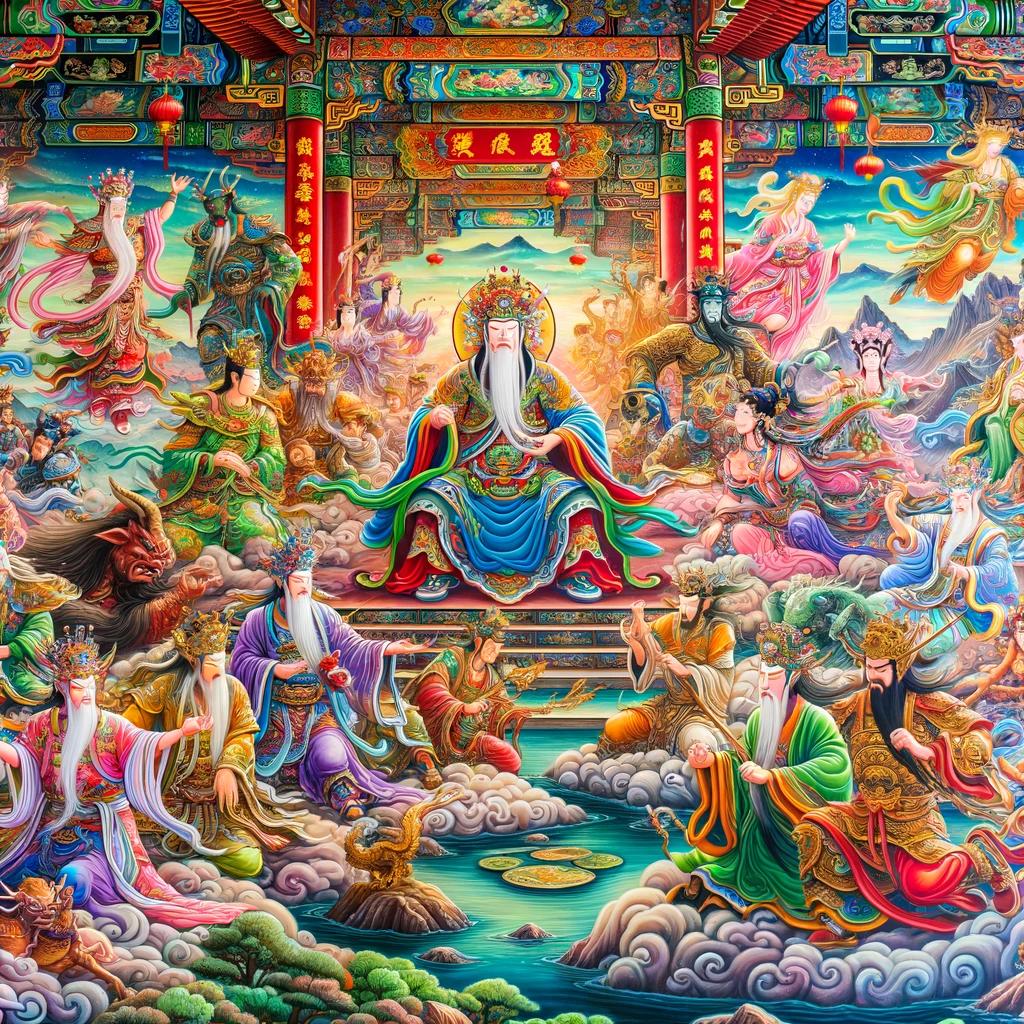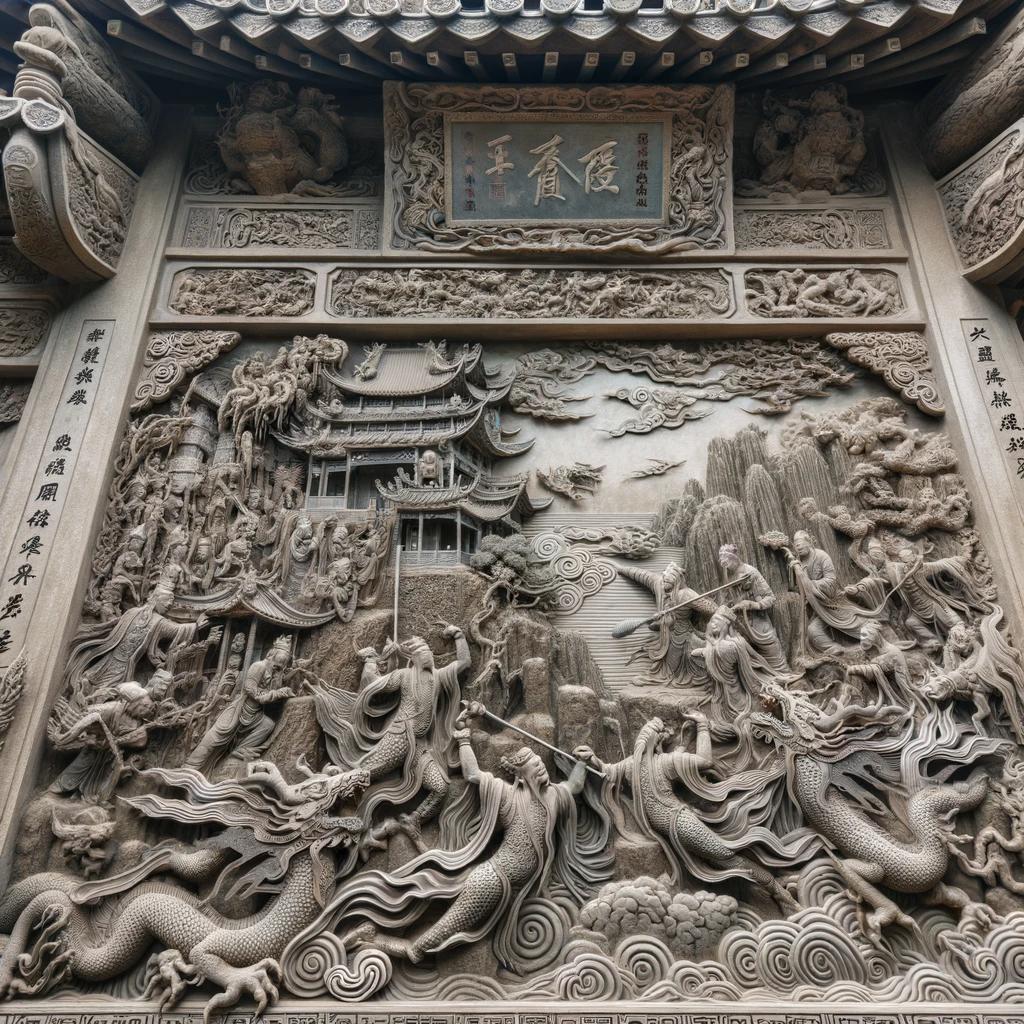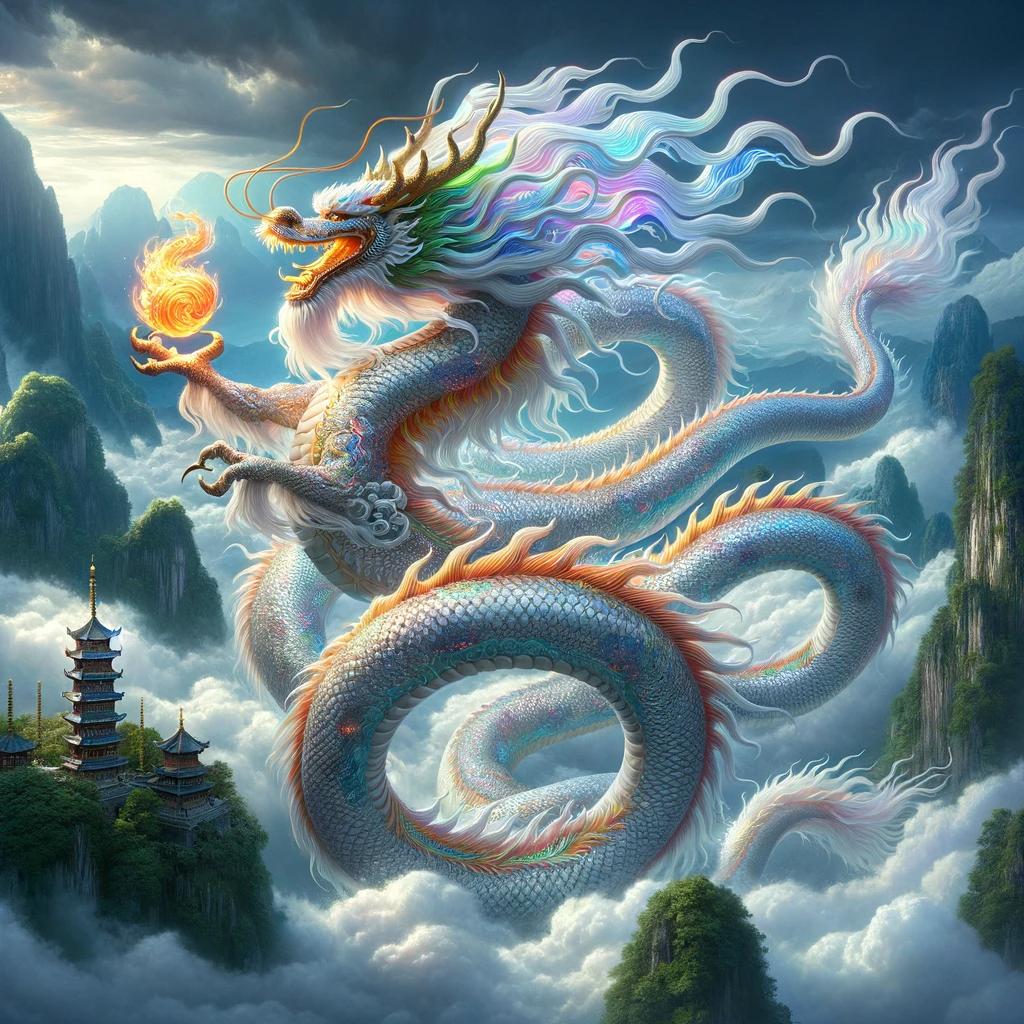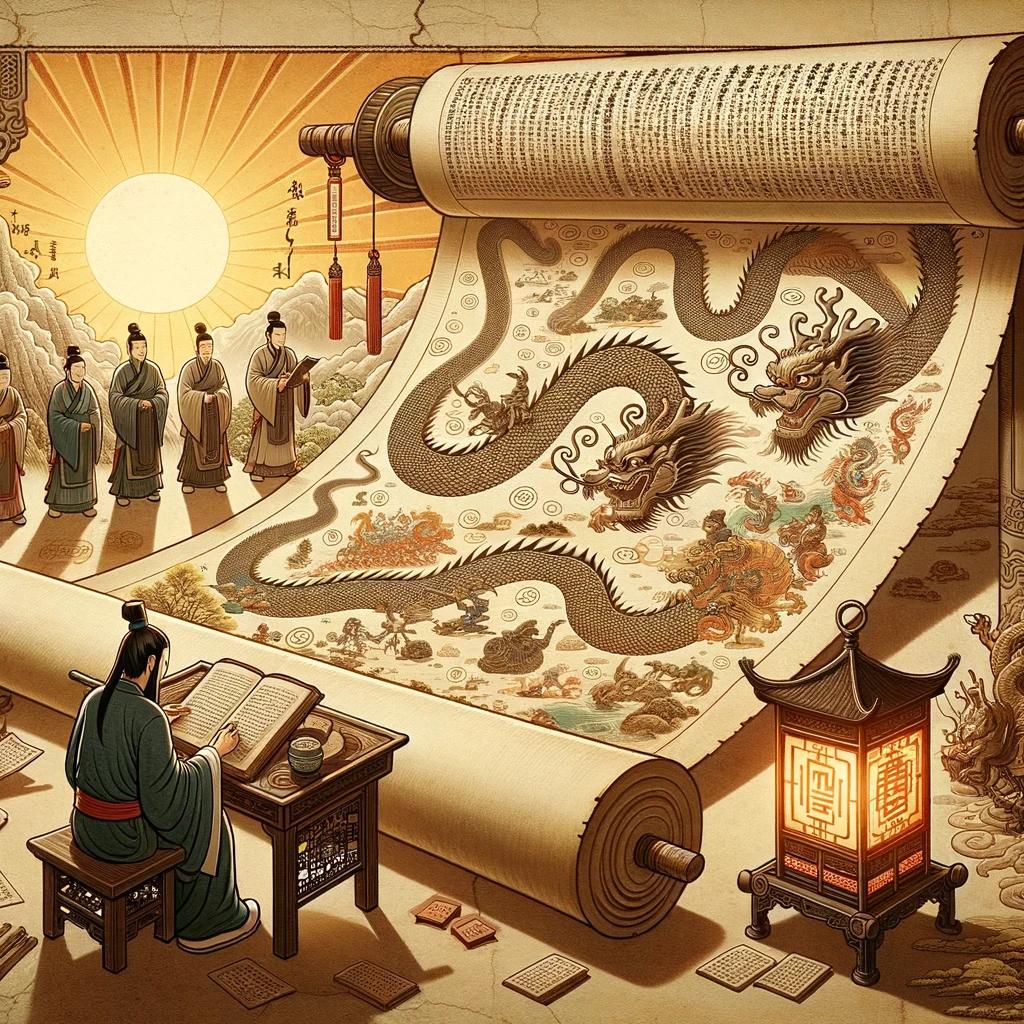Chinese Mythology Dragons: Exploring the Legendary Creatures of China
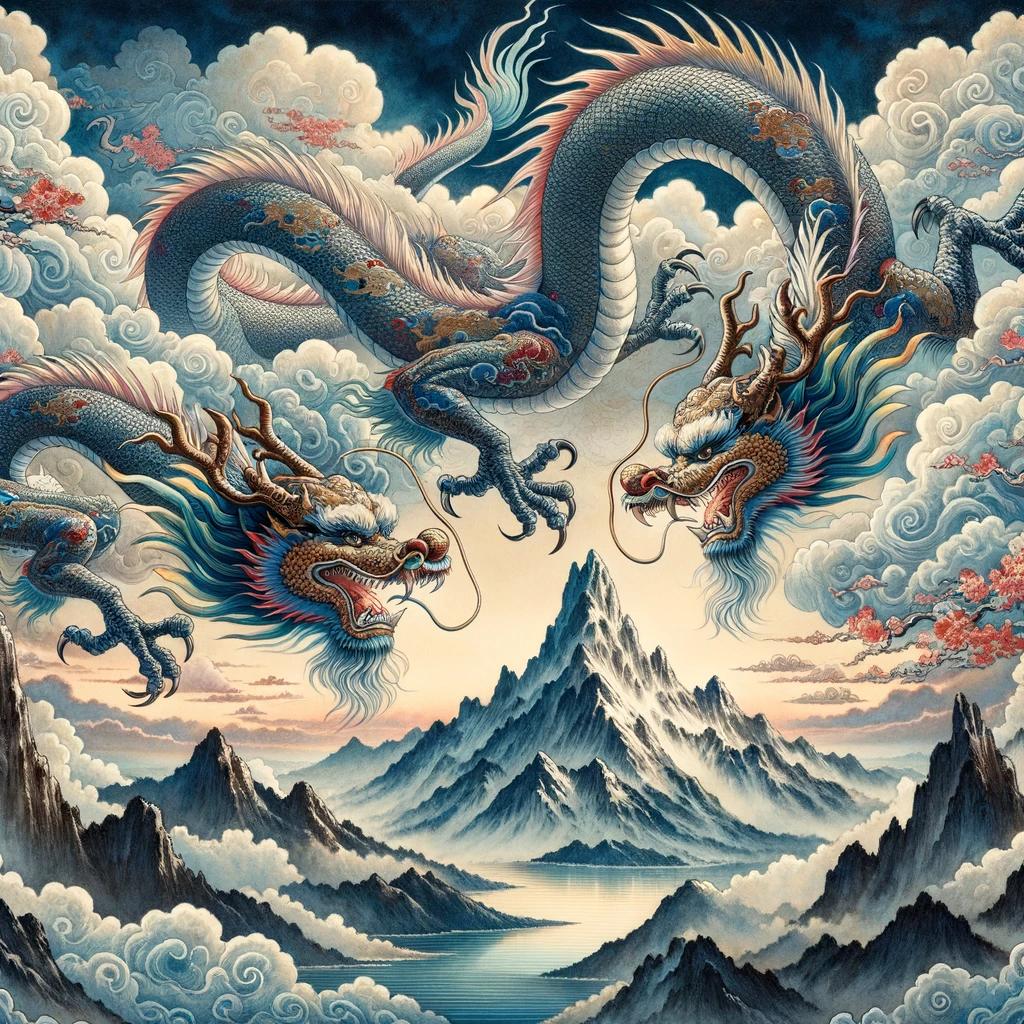
Chinese Mythology Dragons have deep roots in Chinese culture. These legendary creatures symbolize power and fortune, and their association with water and weather control makes them revered figures in China.
From ancient times to modern adaptations, Chinese dragons have had a significant influence on art, architecture, festivals, and even the Chinese zodiac. Explore the origins, symbolism, and cultural significance of these mythical creatures in this comprehensive article.
Chinese Mythology Dragons
The world of Chinese mythology is rich with fascinating creatures, and among them, dragons hold a place of great significance. Dragons in Chinese mythology are revered creatures, symbolizing power, wisdom, and good fortune.
Let’s explore the origins, history, symbolism, and meaning behind these mythical dragons.
Origins and History of Chinese Dragons
The origins of Chinese dragons are veiled in ancient legends and myths. They trace their roots back to various theories, including serpents, alligators, thunder worship, and nature worship. Throughout history, Chinese emperors also adopted the dragon as a symbol of imperial power, further enhancing their significance in Chinese culture.
Symbolism and Meaning of Chinese Dragons
Chinese dragons are imbued with rich symbolism. They are believed to have control over water and the ability to influence weather patterns, making them revered figures in China. Representing auspicious and potent powers, these dragons were often seen as mediators between heaven and earth.
- Power and Strength: The dragon symbolizes great power and strength, representing the majesty of celestial beings.
- Wisdom and Knowledge: Dragons are associated with profound wisdom, often depicted as wise creatures in Chinese mythology.
- Good Fortune and Prosperity: Chinese dragons are seen as bringers of good fortune and abundance, attracting prosperity and success.
The significance of Chinese dragons extends beyond their symbolism; they have had a profound influence on various aspects of Chinese culture, including art, architecture, festivities, and even the Chinese zodiac.
Understanding their origins and symbolism gives us a glimpse into the rich tapestry of Chinese mythology and the enduring legacy of these incredible creatures.
Japanese Dragon: A Comparison to Chinese Dragons
The Japanese dragon, known as “Ryū” in Japanese mythology, shares similarities with its Chinese counterpart but also possesses distinct characteristics that set it apart.
While both dragons symbolize power, they differ in appearance and symbolism.
Unlike the long, serpentine form of Chinese dragons, Japanese dragons are depicted as having a more compact body, resembling large, winged serpents.
They typically possess three toes on each foot, while Chinese dragons often have four or five toes. This distinction highlights the cultural and artistic differences between the two traditions.
In Japanese mythology, dragons are seen as water spirits and guardians of the sea, rivers, and rain.
They are associated with rainfall, which is essential for agriculture and prosperity. Chinese dragons, on the other hand, are closely tied to water as well but are also connected to other elements such as earth, sky, and weather control.
Additionally, the symbolism of Japanese dragons extends beyond power and good fortune. They are often regarded as protectors and bringers of blessings, representing wisdom, longevity, and transformation. These attributes align with the spiritual beliefs ingrained in Japanese culture, emphasizing harmony with nature and personal growth.
While both Chinese and Japanese dragons hold significant cultural importance, their different interpretations and symbolism reflect the unique perspectives and traditions of each culture. Understanding these distinctions can offer valuable insights into the rich mythologies and artistic representations of dragons in both Chinese and Japanese history.
The Four Mythical Dragons in Chinese Culture
In Chinese culture, there are four mythical dragons that hold significant symbolism and represent different aspects of nature and power. These dragons are revered and have been an integral part of Chinese mythology for centuries.
- Long Dragon: The Long Dragon, also known as the Yinglong, is the most commonly depicted dragon in Chinese culture. It is believed to have control over rain and water, symbolizing abundance and fertility.
The Long Dragon is often portrayed with a serpentine body and a fiery pearl, representing wisdom and spiritual enlightenment.
- Lung Dragon: The Lung Dragon, sometimes referred to as the Fu Dragon, is associated with wind and clouds. It is depicted with a powerful and majestic appearance, often seen as a guardian of the heavens.
The Lung Dragon symbolizes strength, protection, and authority.
- Fei Lian Dragon: The Fei Lian Dragon, also known as the Flying Dragon or the Wind Dragon, is associated with storms and tempests. It is believed to have the ability to control the winds and bring rain.
The Fei Lian Dragon is often depicted with wings and fierce features, symbolizing unpredictability and the forces of nature.
- Qiulong Dragon: The Qiulong Dragon, also referred to as the Horned Dragon, is associated with waterfalls and flowing rivers. It is often portrayed with multiple horns on its head and a serpentine body, representing its connection to water and abundance.
The Qiulong Dragon symbolizes power, courage, and vitality.
Each of these four mythical dragons holds a distinct place in Chinese culture and mythology, embodying different aspects of nature and elemental forces. They are revered for their power and bring forth a sense of awe and admiration in Chinese folklore and traditions.
The Divine Azure Dragon in Chinese Mythology
In Chinese mythology, the Divine Azure Dragon holds a significant place. Also known as the Blue, Green, or Verdant Dragon, it represents the east, the season of spring, and the element of wood.
It is one of the Four Mythical Creatures of Chinese folklore, along with the White Tiger, the Vermilion Bird, and the Black Turtle.
The Azure Dragon is associated with benevolence, prosperity, and protection.
It is often depicted as a majestic creature with a serpentine body, four legs, and a pair of wings. Its scales shimmer in shades of blue and green, symbolizing vitality and life-giving energy.
- The Azure Dragon is believed to guard the heavens and control the rain, influencing the weather patterns that bring life to crops and ensure bountiful harvests.
- Legend has it that the Azure Dragon also serves as the mount for the deities and immortals, carrying them between the mortal realm and the divine realm.
- In Chinese cosmology, the Azure Dragon is associated with the concept of Qi, the life force that flows through all living beings.
It is believed to bring balance and harmony to the world.
The Divine Azure Dragon has deep roots in Chinese history and culture. It is often depicted in various art forms such as paintings, sculptures, and textiles, showcasing its majesty and cultural significance.
The Azure Dragon’s symbolism extends beyond mythology and permeates different aspects of Chinese society, from traditional celebrations and festivals to architectural design.
Today, the Divine Azure Dragon continues to captivate and inspire people, serving as a powerful symbol of strength, vitality, and the natural world.
Dragon Symbolism in Chinese Art and Architecture
Dragon symbolism holds great significance in Chinese art and architecture, portraying the mythical creature’s power and cultural importance. The use of dragon motifs, depictions in paintings and textiles, as well as their incorporation in architecture and sculptures, showcases the enduring artistic and architectural traditions influenced by Chinese mythology.
Dragon Motifs in Jade and Ceramics
Jade and ceramics in Chinese art often feature intricate dragon motifs. The smooth, translucent beauty of jade is adorned with meticulously carved dragons, representing good fortune, protection, and strength. Similarly, ceramics showcase vibrant dragon designs, serving as symbols of auspiciousness and prosperity.
Dragon Depictions in Paintings and Textiles
Dragons are vividly depicted in Chinese paintings and textiles, capturing their mythical essence. Paintings showcase dynamic dragon imagery with bold brushstrokes, symbolizing power and vitality. Textiles, including silk garments and tapestries, often depict dragons in various forms, highlighting their influence on fashion and cultural aesthetics.
Dragon Architecture and Sculptures
Chinese architecture is adorned with dragon motifs, seen in ornate rooftops, pillars, and decorative elements of temples, palaces, and traditional buildings. The dragon’s architectural presence symbolizes divine protection and imperial authority.
Dragon sculptures, both free-standing and as part of architectural embellishments, manifest the creature’s majestic presence, guarding sacred spaces and leaving a lasting impression on visitors.
In summary, the deep symbolism of dragons in Chinese art and architecture encompasses the uniqueness of jade and ceramic motifs, the dynamic portrayal in paintings and textiles, and their grand architectural presence in structures and sculptures.
Dragon Worship and Festivals in Chinese Culture
Dragon worship holds a significant place in Chinese culture, with various festivals and traditions dedicated to these majestic creatures. Let’s explore two notable aspects: Dragon Boat Races and Chinese New Year Celebrations.
Dragon Boat Races
Dragon Boat Races are exhilarating events that take place during special occasions, usually around the Dragon Boat Festival, which falls on the fifth day of the fifth month of the lunar calendar.
In these races, elaborately decorated boats resembling dragons compete against each other in a thrilling spectacle. Teams of rowers paddle their boats to the rhythmic beat of drums, while a dragon head leads the way.
The races symbolize the attempt to rescue the legendary poet and statesman Qu Yuan from the Miluo River by beating the water and preventing the dragons from harming him.
Chinese New Year Celebrations and Dragons
Chinese New Year, also known as Spring Festival, is the most important traditional holiday in China.
It is a time of grand celebrations marked by vibrant parades and performances where dragon symbolism plays a prominent role. During the festivities, a long, undulating dragon made of fabric, paper, and bamboo, carried by multiple participants, dances its way through the streets.
The mesmerizing Dragon Dance symbolizes good luck, prosperity, and the warding off of evil spirits for the coming year. Firecrackers and loud drums accompany the dance, enhancing the joyous atmosphere.
These dragon-centric events are cherished and eagerly awaited by the Chinese people.
They not only provide an opportunity to showcase their cultural heritage but also evoke a sense of unity and pride among the participants and spectators alike.
Dragon Legends and Stories in Chinese Mythology
Dragon Legends and Stories in Chinese Mythology are rich with fascinating tales passed down through generations.
These mythical creatures have captured the imaginations of people for centuries, and their significance in Chinese culture cannot be overstated. Let’s explore two significant aspects within this realm: Dragon Kings and Dragons in Folklore, as well as the Nine Sons of the Dragon and Their Significance.
Dragon Kings and Dragons in Folklore
Within Chinese mythology, Dragon Kings are powerful entities who rule over bodies of water, such as oceans, rivers, and lakes. They are depicted as wise and benevolent beings, possessing the ability to control water and influence weather patterns.
Each of the Dragon Kings governs a specific region, often with unique characteristics tied to their domain. Their tales intertwine with legends of heroes and carry moral lessons about respect for nature and the consequences of disobeying natural laws.
Dragons in Chinese folklore extend beyond their association with Dragon Kings. They are prevalent in various tales, often portrayed as majestic creatures associated with both blessings and challenges. These stories often feature encounters between dragons and humans, highlighting courage, wisdom, and the importance of balance in one’s actions.
Nine Sons of the Dragon and Their Significance
According to Chinese mythology, the Dragon has nine sons, each possessing distinct traits and abilities. These sons, known as Jiǔlóng zhī zǐ in Mandarin, hold their place in folklore and symbolize different aspects of life and the natural world.
Let’s explore the symbolic significance of the Nine Sons of the Dragon:
- Tiān Lóng – Symbolizes the sky and rain, representing meteorological phenomena.
- Shuǐ Lóng – Governs water and controls rainfall, representing the power of water in sustaining life.
- Fēng Lóng – Represents wind and storms, embodying the strength and sometimes destructive nature of wind.
- Chén Lóng – Connected to thunder and lightning, symbolizing the powerful forces of nature.
- Quàn Lóng – Associated with whirlpools and deep waters, representing hidden dangers and the depths of the sea.
- Bì Lóng – Portrays dense fog and mist, symbolizing ambiguity and mystery.
- Fù Lóng – Represents hidden treasures and wealth, symbolizing prosperity and abundance.
- Yǎn Lóng – Associated with geographic features such as cliffs and mountains, representing stability and endurance.
- Pàn Lóng – Symbolizes coiled or coiling dragons and is often associated with remote areas or secluded valleys.
These nine dragon sons have significant roles in Chinese culture, appearing in various legends, folklore, and symbolism throughout history.
The Power of Dragons: Influence on Chinese History
The dragons in Chinese mythology hold immense power and have exerted a significant influence on Chinese history. They were closely associated with imperial authority, playing a pivotal role in ancient China and beyond.
Dragons and Imperial Authority in Ancient China
In ancient China, dragons were regarded as symbols of imperial power. Emperors often associated themselves with dragons, using their imagery as a representation of their divine status and authority. Dragons adorned royal garments, thrones, and palace decorations, reinforcing the emperor’s position as a ruler chosen by the heavens.
The dragon’s association with imperial authority extended to various aspects of governance, including lawmaking, military strategies, and political legitimacy. The emperor’s decrees were believed to carry the divine will of the dragon, ensuring obedience and loyalty from the people.
Dragons in the Han Dynasty and Beyond
The influence of dragons continued to thrive in the Han Dynasty and subsequent periods. Dragons became even more prevalent in art, literature, and official insignias. They were often depicted as guardians of the heavens, playing a vital role in maintaining cosmic order and harmony.
The imperial throne, known as the Dragon Throne, became the ultimate symbol of authority and power. Emperors believed that sitting on this throne connected them directly with the divine dragon, granting them legitimacy and the right to rule.
Dragon Symbolism in Han Dynasty
- The dragon was a symbol of the emperor’s benevolence and wisdom.
- Dragon motifs and designs were extensively used in Han Dynasty architecture and artwork.
- Dragons represented the emperor’s control over natural forces and cosmic energies.
Dragon Influence in Subsequent Dynasties
- Dragons continued to be associated with imperial power and authority in subsequent Chinese dynasties.
- Emperors used dragon imagery to enhance their legitimacy and reinforce their divine mandate.
- Dragons were featured prominently in imperial rituals and ceremonies, symbolizing the emperor’s connection to the spiritual realm.
The power and influence of dragons in Chinese history cannot be overstated.
Their association with imperial authority shaped the governance, culture, and artistic expressions of various dynasties, leaving a lasting impact on China’s rich heritage.
Dragon Influence on Chinese Zodiac and Astrology
Dragons hold a significant influence in Chinese zodiac and astrology, playing a unique role in shaping individual destinies and character traits.
Dragons in the Chinese Zodiac
The Chinese zodiac, or Shengxiao, assigns an animal symbol to each year in a repeating twelve-year cycle. The dragon represents one of these zodiac animals and is considered one of the most powerful.
People born in the Year of the Dragon (龙) are believed to inherit characteristics associated with these majestic creatures. They are known to be charismatic, confident, ambitious, and have natural leadership qualities.
Those born under the sign of the dragon are often creative, brave, and possess a strong desire for success. They are believed to bring good luck and prosperity to those around them.
However, being born in the Year of the Dragon also means increased expectations and responsibilities. Dragons are expected to navigate challenges with grace and determination, as they are seen as protectors and influencers.
Dragon’s Role in Astrological Charts
Within Chinese astrology, the dragon is not only associated with the year of birth but also with specific months, days, and even hours. These additional associations provide further insights into an individual’s personality and compatibility.
The dragon’s influence extends to the 5 elements of Chinese philosophy – Wood, Fire, Earth, Metal, and Water. Each element interacts with the dragon’s energies, shaping different aspects of an individual’s character and fortune.
For example, those born in a Wood Dragon year are believed to be innovative and adaptable, while Fire Dragons are known for their fierce determination and passion. Each combination of the dragon and element adds layers of complexity to astrological readings and predictions.
Astrologers analyze these intricate combinations to provide guidance on love, career, health, and overall life paths, helping individuals make decisions and understand their unique strengths and weaknesses.
Modern Adaptations and Popularity of Chinese Dragons
Chinese dragons continue to captivate popular culture and have seen numerous modern adaptations, solidifying their enduring popularity.
From movies and video games to merchandise and fashion, Chinese dragons hold a special place in contemporary society.
1. Dragon Imagery in Film and Television: Chinese dragons have made their presence known in the entertainment industry.
They have been featured prominently in films like “Crouching Tiger, Hidden Dragon” and television shows like “Avatar: The Last Airbender”. Their visually striking presence and mystical qualities add intrigue to these stories.
2. Dragons in Video Games: Chinese dragons have become iconic figures in the world of gaming. They are often depicted as powerful creatures with magical abilities. Games like “League of Legends” and “Final Fantasy” feature dragon characters that players can interact with or control.
3. Dragon-inspired Fashion: The imagery of Chinese dragons has also found its way into the fashion industry. Inspired by their elegance and symbolism, designers incorporate dragon motifs into clothing, accessories, and jewelry.
These fashion pieces are coveted for their unique and captivating designs.
4. Dragon-inspired Merchandise: Chinese dragons have become popular symbols used on various merchandise items. From home decor and artwork to collectible figurines and even tattoos, people embrace dragon-themed items as a way to tap into the power and mystique associated with these mythical creatures.
5. Dragon Festivals and Parades: Dragon-related festivities continue to thrive in modern times. Dragon boat races and dragon dances are celebrated worldwide, attracting both locals and tourists. These events showcase the vibrancy and cultural significance of Chinese dragons.
As the fascination with Chinese dragons persists, their symbolism and aesthetic appeal remain influential in various aspects of contemporary culture.
.

